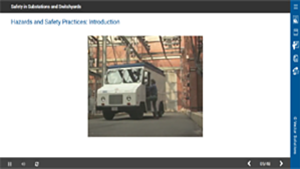
Safety in Substations and Switchyards
The purpose of this course is to teach the basic safety principles and practices applicable to substation and switchyard maintenance work. The course describes electrical, chemical, and personal hazards that may be encountered in substations and switchyards. A general procedure for responding to imminent dangers and accidents is also presented. At the conclusion of this course, participants should be able to identify hazards in substations and switchyards and explain why safety practices are important. They should be able to recognize hazards and unsafe practices on the job, and they should have a general understanding of how to respond to imminent dangers and accidents.
Request a demoCourse Details
Learning Objectives
Hazards and Safety Practices
Specs
| Course Level | Intermediate |
| Languages | English |
| Compatibility | Audio, Video, MobileReady |
Course Applies To
Demos + Pricing
Learn more about our courses, get pricing, and see our platform.











